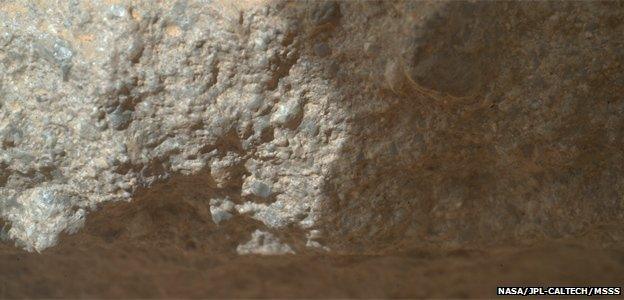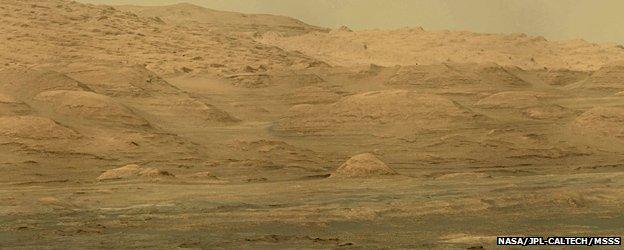Mars rover makes science 'pit stop'
- Published

Curiosity pictured Darwin (light streaks in the lower-centre) on its approach to the waypoint
After two months of solid driving, the Curiosity Mars rover has finally parked for a few days of intense science.
It will be studying the rocks under its wheels, trying to relate them to the outcrops seen earlier in the mission.
The Nasa robot will be using just its remote-sensing instruments. There is no expectation to drill.
Curiosity plans to make five such stop-overs as it pushes forward to the foothills of Mount Sharp, the big peak that dominates equatorial Gale Crater.
Project scientist Prof John Grotzinger told BBC News the rover would be at its current location for "a few sols only". A sol is a Martian day, which is 39 minutes longer than an Earth day.
The first waypoint will give researchers an opportunity once more to examine conglomerate, a rock type made up of small pebbles cemented together by finer material.
On Earth, this is a product of sediment transport in rivers, and indicates that water also flowed across the floor of Gale billions of years ago.
Curiosity, external has previously taken pictures of conglomerate as it rolled by the outcrops, but the stop-over is a chance to acquire much more detail.
"As you recall, we never got to analyse the conglomerate [earlier in the mission]. However, if you look at the most recent images, you'll see that we may finally get our chance - we have passed by several exposures of the conglomerate and now we're parked on it. It's looking very promising," said Prof Grotzinger.
The conglomerate location has been dubbed "Darwin".

Conglomerate at Darwin: Curiosity's "hand-lens", Mahli, reveals the cemented pebbles
The mission team has divided the floor of the crater into series of squares each about 1.5km (one mile) wide.
These quads are used to map out the geology in Gale and to help plan the drive to Mount Sharp.
The two-month drive has taken Curiosity out of the square where it has spent most of its time on the planet since landing in August 2012 and into a new zone.
"Darwin comes from a list of 100 names the team put together to designate rocks in the Mawson Quadrangle - Mawson is the name of a geologist who studied Antarctic geology," said Prof Grotzinger.
"Recently, we left the Yellowknife Quadrangle, so instead of naming rocks after geological formations in Canada's north, we now turn to formation names of rocks from Antarctica, and Darwin is one of them. That will be the theme until we cross into the next quad."
Curiosity has now driven a total of 2.9km on Mars. More than two-thirds of this distance has been clocked up since early July.
The rover is tracking the base of Mount Sharp, aiming to get to a point where it can cross a wide segment of sand dunes. This bridge provides the safest route to the spectacular foothills. It is, however, still several kilometres to the south west of Darwin, and it will be many months yet before Curiosity arrives at its target destination.
Nonetheless, engineers have been delighted by the robot's progress to date. New software has allowed the vehicle to navigate itself on occasions, using pictures taken during a drive to calculate the best path ahead.
It used this system, together with human commands, to cover 141m on 5 September - its biggest one-day drive so far.
Curiosity has already fulfilled its main mission goal, which was to establish that Gale had conditions in its ancient past that could have permitted microbial life to flourish.
The future investigations will fill out this picture.

The rover is trying to get to the foothills of Mount Sharp but must skirt a potential sand trap in front
Jonathan.Amos-INTERNET@bbc.co.uk and follow me on Twitter: @BBCAmos, external
- Published6 August 2013
- Published10 July 2013
- Published8 July 2013
- Published3 June 2013
- Published31 May 2013
- Published30 May 2013